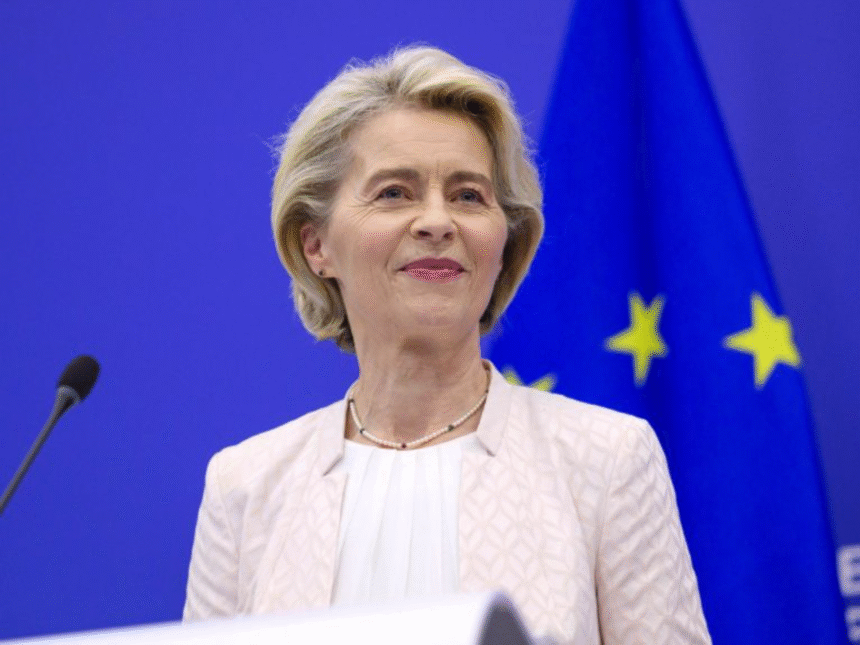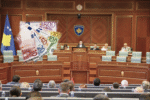With indications that the United States may not provide long-term funding for Ukraine’s defense, the European Union is exploring ways to cover a larger share of costs in 2026 and 2027, anticipating the conflict will continue.
The proposal was first hinted at during European Commission President Ursula von der Leyen’s annual speech to the European Parliament in early September, where she mentioned the idea of a “reparations-backed loan.”
Further details were outlined in a one-page discussion document circulated to EU member states. The document, seen by Radio Free Europe (RFE), was briefly discussed by EU ambassadors on September 26. Von der Leyen is expected to present it at an informal EU summit in Copenhagen on October 1, with Ukrainian President Volodymyr Zelensky likely in attendance. EU finance ministers will review the plan in more detail at a meeting in Luxembourg next week.
How the Loan Would Work
Any loan to Ukraine would be backed by frozen Russian assets in the EU, which have been blocked since Russia’s full-scale invasion of Ukraine in early 2022. The funds would not be directly used, and Ukraine would only be required to repay once Russia pays war reparations.
The reparations-backed loan could address multiple challenges:
- It would provide Ukraine with necessary funding without risking vetoes from skeptical EU countries like Hungary and Slovakia.
- It would clarify the use of Russian assets and reduce pressure on the EU budget.
Potential Obstacles
The EU currently has an estimated €176 billion in frozen Russian assets, primarily held in Euroclear, a Belgian central securities depository. Some countries, particularly the Baltics, have long advocated for confiscating these funds to support Ukraine or strengthen European defense.
However, many Western countries oppose direct confiscation. Belgium fears lawsuits from Moscow against the country or Euroclear. The European Central Bank (ECB) is concerned about potential impacts on the euro’s status as the world’s second-largest reserve currency. Major EU states prefer keeping the funds frozen for possible post-war reconstruction if Russia refuses to pay reparations.
Currently, some of the frozen assets are already generating quarterly profits—around €1.5 billion—that are immediately transferred to Ukraine.
The “Coalition of the Willing” Proposal
The European Commission now proposes that some or all frozen assets in Euroclear be transferred to a Special Purpose Vehicle (SPV), in exchange for zero-coupon bonds issued by the Commission. These bonds would be backed by guarantees from a “Coalition of the Willing”, composed of EU countries and possibly other G7 democracies.
Funds in the SPV would then be loaned to Kyiv over 2026 and 2027, potentially longer. Ukraine would repay only once Russia compensates for war damages. The total amount could reach €140 billion, depending on IMF assessments, with most of the funding likely coming from Europe if the U.S. opts out.
This mechanism would avoid national vetoes. A similar issue arose in early 2024, when Hungary initially blocked a €50 billion EU support package for Ukraine (2024–2027). While €32 billion has already been transferred, remaining funds are limited, and Hungary may oppose further disbursement.
Legal and Political Challenges
- Frozen Russian assets would remain blocked until the EU decides otherwise, with reviews in July and January each year.
- Any future extension of sanctions would require a qualified majority, likely needing high-level political agreement from most EU leaders.
- There are questions over how many countries would participate in the Coalition of the Willing, as participation requires national parliamentary approvals and some countries face rising deficits.
- Euroclear may demand full guarantees and a governance role in the SPV. Other financial institutions holding Russian assets might also be asked to contribute.
The European Commission’s plan aims to ensure Ukraine’s urgent funding needs are met while mitigating political and legal risks within the EU.







